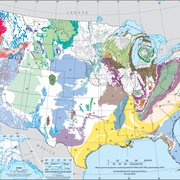As part of the Hawai‛i Volcanic-Rock Aquifer Study, water-budget models were used to compute groundwater recharge and other water-budget components for four of the Hawaiian Islands: Kaua‛i, O‛ahu, Maui, and Hawai‛i Island.

The main islands of Hawai‛i are formed by enormous basaltic shield volcanoes that were built from the ocean floor by mid-plate hot-spot volcanism. The islands are successively younger toward the southeast of the chain, with Miocene-age basalt on Ni‛ihau and Kaua‛i at the northwestern end and active volcanoes on the Big Island at the southeastern end. The shield volcanoes along the island chain are also at different stages of geologic development. Lava flows from three stages in the life of Hawaiian volcanoes–shield, postshield, and rejuvenation–formed the land mass above sea level. This webpage provides links to download geospatial data associated with the Hawai‛i Volcanic-Rock Aquifer study and Volcanic aquifers of Hawai‘i—Hydrogeology, water budgets, and conceptual models (USGS Scientific Investigations Report 2015-5164).
As part of the Hawai‛i Volcanic-Rock Aquifer Study, water-budget models were used to compute groundwater recharge and other water-budget components for four of the Hawaiian Islands: Kaua‛i, O‛ahu, Maui, and Hawai‛i Island. The water-budget components were computed for predevelopment, recent, and current conditions, as described in USGS Scientific Investigations Report 2015-5164. Spatial datasets used within the model were those that characterize the spatial distribution of hydrologic and physical conditions (rainfall, fog interception, irrigation, reference evapotranspiration, direct runoff, soil type, and land cover) that were used to compute groundwater recharge and other water-budget components. The downloadable shapefiles below include information for those attributes. The recharge estimates may be used in numerical groundwater models that can evaluate the effects of groundwater withdrawals on groundwater levels, streamflow, coastal discharge, and salinities in public and private wells.
Click on the links below to download files for this aquifer. For information about the available file types, see Aquifer data: Explanation of spatial data formats.
Mean annual water-budget components for Kaua‛i, O‛ahu, Maui, and Hawai‛i Island (USGS Science Data Catalog search)
Below are other science projects associated with this aquifer.
Principal Aquifers of the United States
Regional Groundwater Availability Studies
Below are publications associated with this aquifer.
Volcanic aquifers of Hawai‘i—Hydrogeology, water budgets, and conceptual models Volcanic aquifers of Hawai‘i—Hydrogeology, water budgets, and conceptual models
Ground Water Atlas of the United States Ground Water Atlas of the United States
Principal aquifers [of the United States] Principal aquifers [of the United States]
As part of the Hawai‛i Volcanic-Rock Aquifer Study, water-budget models were used to compute groundwater recharge and other water-budget components for four of the Hawaiian Islands: Kaua‛i, O‛ahu, Maui, and Hawai‛i Island.

The main islands of Hawai‛i are formed by enormous basaltic shield volcanoes that were built from the ocean floor by mid-plate hot-spot volcanism. The islands are successively younger toward the southeast of the chain, with Miocene-age basalt on Ni‛ihau and Kaua‛i at the northwestern end and active volcanoes on the Big Island at the southeastern end. The shield volcanoes along the island chain are also at different stages of geologic development. Lava flows from three stages in the life of Hawaiian volcanoes–shield, postshield, and rejuvenation–formed the land mass above sea level. This webpage provides links to download geospatial data associated with the Hawai‛i Volcanic-Rock Aquifer study and Volcanic aquifers of Hawai‘i—Hydrogeology, water budgets, and conceptual models (USGS Scientific Investigations Report 2015-5164).
As part of the Hawai‛i Volcanic-Rock Aquifer Study, water-budget models were used to compute groundwater recharge and other water-budget components for four of the Hawaiian Islands: Kaua‛i, O‛ahu, Maui, and Hawai‛i Island. The water-budget components were computed for predevelopment, recent, and current conditions, as described in USGS Scientific Investigations Report 2015-5164. Spatial datasets used within the model were those that characterize the spatial distribution of hydrologic and physical conditions (rainfall, fog interception, irrigation, reference evapotranspiration, direct runoff, soil type, and land cover) that were used to compute groundwater recharge and other water-budget components. The downloadable shapefiles below include information for those attributes. The recharge estimates may be used in numerical groundwater models that can evaluate the effects of groundwater withdrawals on groundwater levels, streamflow, coastal discharge, and salinities in public and private wells.
Click on the links below to download files for this aquifer. For information about the available file types, see Aquifer data: Explanation of spatial data formats.
Mean annual water-budget components for Kaua‛i, O‛ahu, Maui, and Hawai‛i Island (USGS Science Data Catalog search)
Below are other science projects associated with this aquifer.
Principal Aquifers of the United States
Regional Groundwater Availability Studies
Below are publications associated with this aquifer.



